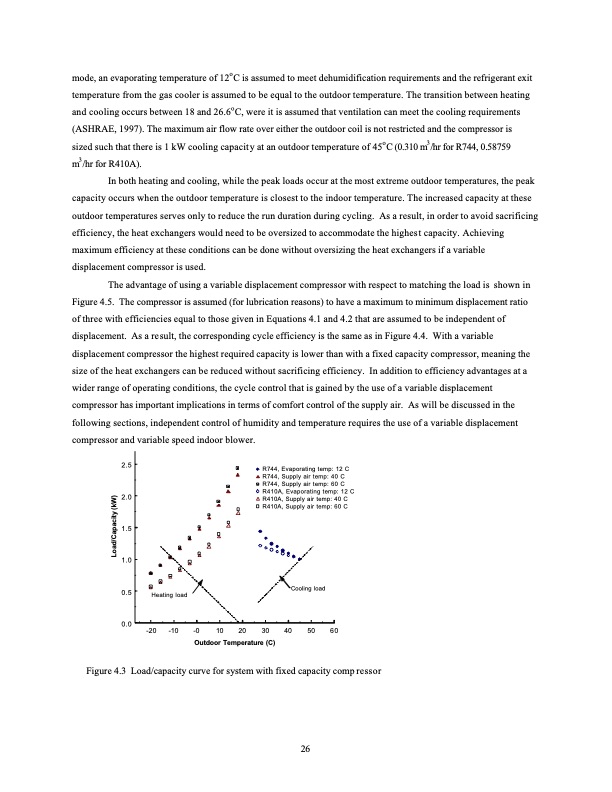
PDF Publication Title:
Text from PDF Page: 037
mode, an evaporating temperature of 12oC is assumed to meet dehumidification requirements and the refrigerant exit temperature from the gas cooler is assumed to be equal to the outdoor temperature. The transition between heating and cooling occurs between 18 and 26.6oC, were it is assumed that ventilation can meet the cooling requirements (ASHRAE, 1997). The maximum air flow rate over either the outdoor coil is not restricted and the compressor is sized such that there is 1 kW cooling capacity at an outdoor temperature of 45oC (0.310 m3/hr for R744, 0.58759 m3/hr for R410A). In both heating and cooling, while the peak loads occur at the most extreme outdoor temperatures, the peak capacity occurs when the outdoor temperature is closest to the indoor temperature. The increased capacity at these outdoor temperatures serves only to reduce the run duration during cycling. As a result, in order to avoid sacrificing efficiency, the heat exchangers would need to be oversized to accommodate the highest capacity. Achieving maximum efficiency at these conditions can be done without oversizing the heat exchangers if a variable displacement compressor is used. The advantage of using a variable displacement compressor with respect to matching the load is shown in Figure 4.5. The compressor is assumed (for lubrication reasons) to have a maximum to minimum displacement ratio of three with efficiencies equal to those given in Equations 4.1 and 4.2 that are assumed to be independent of displacement. As a result, the corresponding cycle efficiency is the same as in Figure 4.4. With a variable displacement compressor the highest required capacity is lower than with a fixed capacity compressor, meaning the size of the heat exchangers can be reduced without sacrificing efficiency. In addition to efficiency advantages at a wider range of operating conditions, the cycle control that is gained by the use of a variable displacement compressor has important implications in terms of comfort control of the supply air. As will be discussed in the following sections, independent control of humidity and temperature requires the use of a variable displacement compressor and variable speed indoor blower. 2.5 2.0 1.5 1.0 0.5 Cooling load Heating load 0.0 -20 -10 -0 10 20 30 40 50 60 Outdoor Temperature (C) Figure 4.3 Load/capacity curve for system with fixed capacity comp ressor R744, Evaporating temp: 12 C R744, Supply air temp: 40 C R744, Supply air temp: 60 C R410A, Evaporating temp: 12 C R410A, Supply air temp: 40 C R410A, Supply air temp: 60 C 26 Load/Capacity (kW)PDF Image | Comparison of R744 and R410A

PDF Search Title:
Comparison of R744 and R410AOriginal File Name Searched:
CR039.pdfDIY PDF Search: Google It | Yahoo | Bing
CO2 Organic Rankine Cycle Experimenter Platform The supercritical CO2 phase change system is both a heat pump and organic rankine cycle which can be used for those purposes and as a supercritical extractor for advanced subcritical and supercritical extraction technology. Uses include producing nanoparticles, precious metal CO2 extraction, lithium battery recycling, and other applications... More Info
Heat Pumps CO2 ORC Heat Pump System Platform More Info
| CONTACT TEL: 608-238-6001 Email: greg@infinityturbine.com | RSS | AMP |